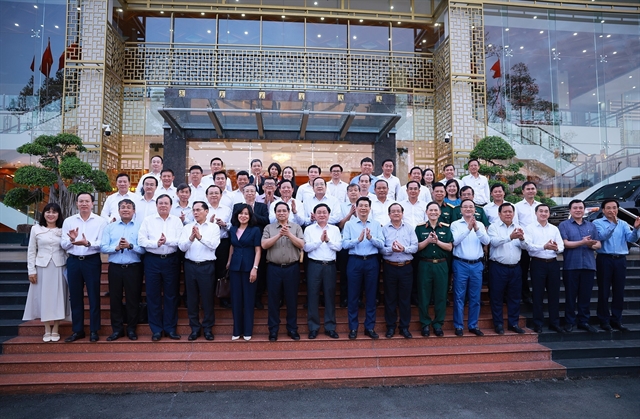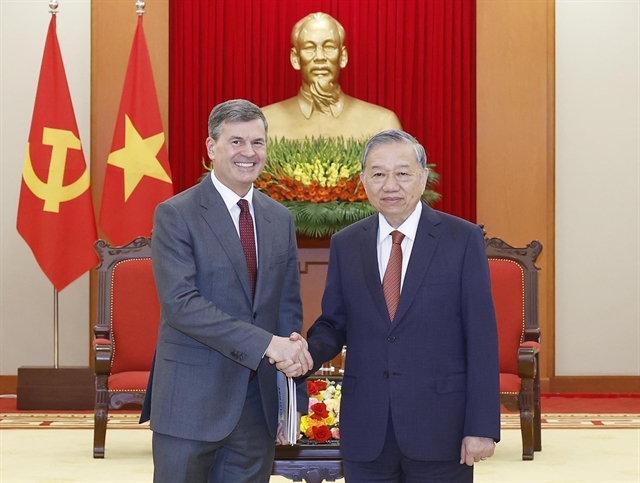 Economy
Economy

A new year has come bringing with it many new opportunities and challenges. Việt Nam News asked some senior business executives and a diplomat how they see prospects for Việt Nam and their own sectors
By Thu Ngân & Xuân Hương
A new year has come bringing with it many new opportunities and challenges. Việt Nam News asked some senior business executives and a diplomat how they see prospects for Việt Nam and their own sectors
Juliana Lee, Deutsche Bank Senior Economist
 |
| Juliana Lee (L), Deutsche Bank Senior Economist |
We expect Việt Nam to post a stronger GDP growth of 6.4 per cent in 2017, up from 6.2 per cent last year. We took a relatively cautious view given the adverse external policy conditions. At the moment, we think the more important thing for Việt Nam, underlined by the Government, is progress in its economic reforms.
It appears there is a shift in the government’s policy priority, away from over reliance on loose macro policy and the public sector for growth, in favour of economic reforms and the private sector’s growth to boost productivity and thereby growth. They would be very positive for Việt Nam. Moreover, SOE reforms would leave the public sector more efficient and improve Việt Nam’s fiscal health.
The Prime Minister recently talked about raising the limits on the foreign investment in banks. In our view, this reflects the government’s commitment to economic reforms. A significant progress in SOE reforms and/or bad debt resolution bodes very well for Việt Nam’s future. It poses upside risks to Việt Nam’s growth and the đồng. We currently have the đồng depreciating against the US dollar at around 4-5 per cent this year, in line with moves in most of its trading partners’currencies, keeping the đồng’s real exchange rate relatively stable. However, in case of a significant progress in economic reforms, that attract larger than expected capital inflows into Việt Nam, we could see the đồng strengthen instead.
Sean Preston - Visa County Manager in Vietnam, Cambodia & Laos
 |
| Sean Preston - Visa County Manager in Vietnam, Cambodia & Laos |
We are witnessing strong growth in e-commerce as Vietnamese consumers are embracing the convenience, competitive prices and greater range of products available to them online.
According to Internet Live Stats online, 52 per cent of Việt Nam’s population of 94 million are using the internet, and 62 per cent of the internet users shop online.
Việt Nam is a truly vibrant, growing market. In such a short time commerce in this country has grown much more advanced, and consumers are really arming themselves with knowledge.
The country’s e-commerce penetration rate places high amongst its counterparts in the region, but it also shows that there is still great opportunity for more Vietnamese to experience the benefits of shopping online.
We’ve seen really strong uptake of our Visa debit products, which we expect will continue in the medium term. This has the capacity to drive even greater e-commerce consumption, as these payment products allow Vietnamese online shoppers to purchase from international sellers rather than simply rely on cash on delivery through a local merchant. Given what we’ve seen so far in terms of our own research, we are optimistic about the attitudes of Vietnamese consumers towards electronic payments, whether it’s for shopping online, overseas, or at their local supermarket.
Dương Thuỳ Dung, director of Research and Consulting, CBRE Vietnam
 |
| Dương Thuỳ Dung, director of Research and Consulting, CBRE Vietnam |
The Vietnamese property market has been attracting investors. Most of them are from Asia.
CBRE has seen that investors interested in the Vietnamese market are mostly from North Asian countries like South Korea and Japan.
Some of them have worked with us for three or four years and last year had officially entered the market by co-operating with Vietnamese investors or buying shares of listed companies.
Meanwhile, there are new investors from traditional markets like Singapore and Hong Kong.
Last year the market witnessed the appearance of investors from the US and China.
Two or three years ago some investors from China had worked with us but had temporarily stopped. Now they have come back seeing there is no risk and the market has become more stable.
Late last year at least three groups of investors from China had worked with us to study the market.
All the above signs show there will be more interest in the Vietnamese property market this year.
There will be new faces from traditional markets. There will also be investments from neighbouring markets and new markets like the US.
US Consul General Mary Tarnowka
 |
| US Consul General Mary Tarnowka |
The US-Vietnam bilateral trade relationship has never bee
n stronger. Trade between our two countries has nearly tripled in the last eight years, and now tops US$45 billion. US exports to Việt Nam totalled $8.4 billion through October 2016, making Vietnam the fastest growing export market for the US. The US remains Vietnam’s largest export market, growing 24 percent year-on-year.
With or without the Trans Pacific Partnership Agreement, our mutual economic interests endure. I expect that our trade and investment relationship will continue to grow, promoting prosperity and sustainable development. We are encouraged by Việt Nam’s recent resolution on international economic integration, reaffirming its intention to continue its economic reforms and further open its economy. These reforms will promote fair, transparent, and predictable regulatory systems that enable innovation and attract trade and investment. Adopting market-oriented reforms and international standards brings lasting benefits –innovation and entrepreneurship, jobs, economic growth, and movement up the global value chain.
The US looks forward to supporting Việt Nam as the 2017 APEC host economy. In this role, Việt Nam has a great opportunity to emphasise the importance of externally oriented, market-driven economic policies that advance regional economic integration and free and open trade and investment.
Dương Ngọc Minh, board chairman and general director of Hùng Vương Corporation
 |
| Dương Ngọc Minh, board chairman and general director of Hùng Vương Corporation |
Việt Nam’s shrimp exports reached a record over US$3.1 billion last year. The exports will be even larger this year, thanks to high demand from China and South Korea.
The US, EU and Japan are traditionally the largest import markets of Vietnamese shrimp, and China and South Korea have recently emerged as large import markets.
Trade deals like the Việt Nam-South Korea, ASEAN-South Korea and Việt Nam-EU FTAs will boost Việt Nam’s seafood exports.
Seafood imports by South Korea for instance increased from $40-50 million a year to $200 million last year, and are expected to continue to increase.
Since 2003 the export market shares of value-added products have increased by 10 per cent a year on average.
Currently 60 per cent of the exports to the US and Japan are of value-added products.
We find it hard to compete with India and Thailand in exporting unprocessed shrimp products.
To retain our competitive advantage, we must work to lower domestic raw material costs.
We have advantages in terms of infrastructure since all our shrimp processing plants are equipped with modern technology. We also have a skilled labour force.
But our raw material costs remain 10-15 per cent higher compared to other countries.
In addition, financial policies and mechanisms like high bank lending interest rates disadvantage shrimp processors and exporters.
In addition, there are intermediaries involved in the production process, who further push up production costs.
With its current installed capacity, Việt Nam is able to process for exports more than $5 billion worth of products a year, but the problem is finding enough raw materials to process for export.
We need to improve planning for shrimp farming to ensure there is a steady source of input materials.
Besides, local agriculture departments should work to reduce the presence of intermediaries in the supply chain. — VNS




